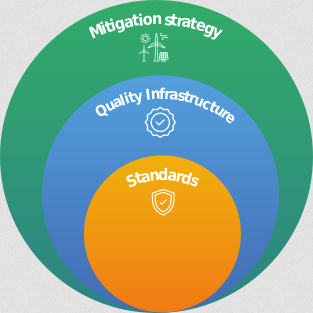As the energy transition accelerates worldwide, power systems with high shares of renewables are due to become the norm in a net-zero and affordable energy future. But the exposure of infrastructure such as wind turbines, solar panels, electricity grids and other renewable energy generators to the increasing occurrence of extreme weather events driven by climate change, highlights the urgent need to make renewables-based power systems more climate resilient.
This challenge calls for an opportunity; to embed resilience into renewable energy strategies through quality infrastructure (QI), smarter planning, and better cross-sector coordination. The following paragraphs explain how increasing resilience does not only reduce costs in the long-term but also strengthen countries' energy security.
The Case for Resilient Power Systems
According to IRENA's World Energy Transitions Outlook 2024, electricity will make up more than half of final energy use by mid-century, with electrification of end-use sectors being an essential driver of the energy transition. The scale of this shift makes resilience planning indispensable.
From heatwaves and droughts, to floods and hurricanes, the increased occurrence and intensity of extreme weather events have highlighted their growing impact on energy infrastructure. Such events can damage power assets and disrupt electricity supply - including for critical services such as health and communications - setting off chain reactions that affect an entire society and put national economies at risk. And this is a global problem despite the specific climate threats faced by different countries.
Clearly, the new, renewables-based power systems cannot rely on their inherent level of resilience. They need to be climate-proof; designed to absorb shocks, recover quickly, and continue providing societies with energy security under frequent and intensified extreme weather events.
Quality Infrastructure: The Foundation of Resilience
Resilience begins with robust quality infrastructure (QI); the ecosystem of standards, testing, certification, and monitoring that supports the safety and performance of energy technologies. By embedding QI across the entire life cycle of renewables' projects, from planning and design to construction and operation, countries can significantly reduce weather-related risks of these projects.

Mitigation strategy based on QI
Establishing QI entails aligning technical specifications with expected -and severe climate conditions, enforcing construction and assembly practices to take potential and foreseen extreme weather events into account, and enabling project operators to monitor systems in real-time in order to respond to weather challenges pre-emptively. QI is not just about technical performance, it is also about financial security. Systems built to be resilient experience higher yields, fewer outages, lower maintenance costs, and greater investors' confidence.
Strategic Planning for Climate Resilience
Climate resilience measures like QI are only effective when it is implemented at scale. Reactive, ad-hoc responses to disruptions are not only insufficient, but also unsustainable. Policymakers can play a leading role by promoting the uptake of resilience-enabling standards in national regulations, investing in local testing capabilities, and integrating resilience criteria into procurement and public tenders. For that reason, climate resilience measures must be integrated into the national power system planning.
Integrating climate resilience into renewable energy policy, planning, and investment, serves to enable long-term change towards sustainability. Countries must be encouraged to develop forward-looking strategies that map vulnerabilities across the power system, evaluate future climate scenarios, and prioritise investment in areas where returns from resilience are highest, as financial benefits are one of the strongest arguments to implement resilience measures.
The costs of preventive measures are consistently more effective than the avoided costs of damages, service interruptions, and long recovery times. Through detailed cost-benefit analysis, countries can identify which resilience investments offer the greatest return and align with public and private fundings.
As part of smarter planning, policymakers can also help de-risk resilience investments by supporting innovative financing tools, such as resilience bonds, concessional loans, and public-private partnerships. This encourages insurers to recognise the value of QI in reducing exposure to climate-related losses.
Appropriate metrics facilitate such valuation. Assessing resilience gaps, estimating potential impacts, and tracking improvements over time help build the case for continued investment and guide resource allocation. These assessments also support transparency and accountability in project planning and implementation.
A holistic approach in the power system includes adapting transmission and distribution infrastructure, integrating distributed energy resources (DERs), and using advanced analytics and smart grid technologies to forecast and mitigate disruptions. DERs as microgrids are especially relevant; they not only expand access to clean energy, but also enhance reliability by decentralising supply and reducing dependence on vulnerable grid segments. When paired with storage and smart meters, they can continue operating even when the main grid is down, offering critical services during emergencies.
A Resilient Future Starts with Collaboration
Prioritising quality infrastructure, upgrading planning processes, and unlocking financing can only be achieved by aligning stakeholders behind the common goal of maximising the benefits of energy transitions. Achieving resilience at scale requires coordination across sectors and stakeholders in positioning renewable energy as the cornerstone of national resilience strategies.
Governments, utilities, investors, manufacturers, and communities each have a role to play. Establishing clear roles and responsibilities and facilitating regular dialogues between parties are key to moving from vision to action. Furthermore, sharing best practices between countries, particularly those with similar climate risks or market conditions, can provide lessons learned that will avoid costly missteps.
For more on the topic of weather and infrastructure, please read Quality infrastructure for renewables facing extreme weather conditions.
Also look forward to another IRENA report on climate-proofing the power systems. Please check https://www.irena.org/Publications in the coming months.









